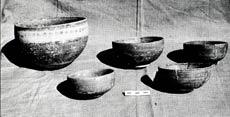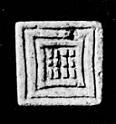Uday Mahurkar
Source - http://indiatoday.intoday.in/story/excavations-throw-new-light-on-harappan-period/1/316411.html

Superior quality pottery
At the end of the first phase of excavations in 1988, the discovery of a Harappan site at Kuntasi, a tiny hamlet in Rajkot district, seemed just an exciting archaeological find. However, subsequent excavations have revealed it to be a gold-mine, containing such rich remains of the Harappan civilisation as are matched only by those found at Lothal - a beautiful port complex that was unearthed in Gujarat in the '50s.
For archaeologists from Gujarat's state Archaeology Department and Deccan College, Pune, who concluded their third phase of excavations last fortnight, the experience has certainly proved to be a rewarding one. Says Dr M.K. Dhavlikar, an expert from Deccan College: "Kuntasi should rank as one of the most important Harappan discoveries." Adds Yunus Chitalwala of the state Archaeology Department: "The most interesting thing about Kuntasi is that it has thrown light on some new facets of the era which other Harappan sites haven't."
The first is the indication of a communal way of living. A major find at Kuntasi - a port-cum-industrial complex during the Harappan period - are the living quarters for craftsmen producing beads, pottery, copper items like rings, bangles, knives and arrowheads. What makes the quarters really unique is the fact that most of the 50-odd rooms are inter-connected, and also that there is only one hearth.
Another important discovery is a seal made of fience (a primitive glass made of cobalt and silica), inscribed with rectangular figures, which has so far only been found in Harappa. In fact, most of the seals at other Harappan sites bear bull and unicorn figures and are made of steatite. According to Dhavlikar, the seals could have been a sign of authority of the person in command of the settlement.
But interestingly, a structure of semi-moon shape in the middle of the living quarters has posed a riddle for the experts. Not seen in other Harappan sites, the structure is, in fact, similar to Chandrashila, which is normally found in Buddhist and Hindu places of worship. The earliest Chandrashila dates back to the 1st century B.C. which was discovered in a Buddhist stupa in Amravati.

Seal with rectangular figures inscribed: Rare find
Chitalwala opines that the Chandrashila-shaped structure probably had something to do with the Harappans' way of worship. And to some extent, the hypothesis is substantiated by the discovery of a large semicircular platform - the likely seat of a religious head - near the Chandrashila.
But probably the most fascinating find is an unusual copper ring bearing two spirals that could be a pointer to interaction between the Harappans and the Cretans. The spiral motif was considered sacred by the Cretan civilisation, which flourished near Greece around the same time as the Indus Valley civilisation.
Moreover, unlike other sites, the settlement has double fortifications. The reason for this, Dhavlikar believes, is that the Harappans came to Kuntasi to exploit its natural resources like carnelia, agate, shells and ivory, and built two fort walls to guard themselves from the hostile local people and animals.
Chitalwala, however, disagrees. He is of the view that the site was inhabited in two phases (1900 B.C. to 1700 B.C. and around 2200 B.C.) and hence the double fortification. The archaeologists have also found a gateway to the fortification and a long underground passage leading to the quarters.
A rich collection of superbly finished pottery made of high quality clay has also been unearthed at the site. The same clay is, incidentally, used in Morvi, a major tile producing centre 30 km away from Kuntasi. One structure at the Kuntasi site has yielded tools like arrowheads and knives made of animal bones, and in another the experts have found a heap of dry fish.
Four chert weights, square and small in size, have also been discovered at the site. Besides, coarse millet (ragi) found during the excavations indicates that it was their staple food. In many Harappan sites wheat and barley have also been unearthed.

The excavated site at Kuntasi: well-preserved
The site has also proved to be the best testimony to the building skills of the Harappans. The orientation of the walls, about 60 cm wide, is perfect. The size of the rooms is about 15 ft by 15 ft. A large portion in the middle of the structure is vacant. There is also a well on the eastern side and a silo, with a diameter of 1.5 m nearby, which forms a beautiful arc.
Kuntasi, in fact, has little in common with other Harappan sites in Gujarat like Rozdi, Rangpur and Uesalpur. Apart from its being a port, its specific type of infrastructure based on maritime trade and industry puts it in a different class.
Again, unlike most sites which are falling apart due to the vagaries of nature, Kuntasi is well preserved. And the state Archaeology Department is making sparse use of cement to keep the stone structure intact.
Till last fortnight, the archaeologists had excavated about 60 per cent of the site - about 1 sq hectare of the total area of 1.5 sq hectare - spending about Rs.3 lakh in the process. To excavate the whole site will take up to three years. Only then, will a complete picture of the fortifications and the open yard in the centre of the mound emerge. As will, doubtless, numerous other exciting findings.